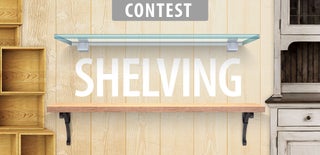Introduction: Cement USB Hub & Shelves
This is part of the USB Hub Challenge. Check out Giaco Whatever's channel - this all started with his Cement USB Hub build on the Make Magazine channel (https://youtu.be/0nt2-RAoLZA). There was a lot of animosity in response to that video, so a bunch of us decided to get together and turn it into something positive. Be sure to check out the playlist in the video description for more.
Step 1: The Hub
I start with a long 12 port USB hub that I picked up on Amazon (http://amzn.to/2dDxxkt)
I pulled off the outer cover and removed the circuit board with all of the ports, now I just need to figure out how to protect this from the cement.
Step 2: Refining the Hub
I used electrical tape around each of the ports and then cut it flush with the top. When I was pouring the cement later, I realized I should have left these long until after and then cut them flush at that point.
Hot glue was used to seal up the ports where they connect to the circuit board. I also reattached part of the front cover to allow for the light on the panel to still pass to the surface.
The back side of the circuit board is also covered with hot glue to protect it. If I were to do this again, I would probably use liquid electrical tape though (this awesome stuff: http://amzn.to/2ifxtYx)
Step 3: Making the Form
I then start to prepare the form for the cement. I used some reclaimed pine paneling for this. With a wire wheel in my angle grinder I pass over the surface to pop out the grain of the wood. This takes off the less dense springwood and leaves behind the denser summerwood. My hopes are to transfer this pattern into the cement.
I then use the miter saw to cut the form down to size. I make sure to cut the the pieces in succession so that the grain will wrap around the different surfaces fluidly matching on the corners.
Each of the mitered corners is temporarily fastened together with staples.
Step 4: Adding the Plastic Spacers
Once I get the form all together and looking perfect, I realize that I forgot to add the spacers to form the grooves for the shelves. I use my speed square to mark out the location of each of the shelves.
Then I use some thin PVC plastic pieces and glue them in place at the same spot and size where I want the shelves to go. This will create grooves in the concrete so the shelves will slide right in.
The entire form is stuck in place to a piece of melamine using hot glue.
Step 5: Pouring the Cement
I took the concrete and sifted out the aggregate because this form was so thin (1-1/2") so the aggregate would make it hard to fill the corners.
I mix the cement with water until it's like peanut butter and then dump it into the form with my trowel.
The USB hub is pushed into the wet cement in one of the legs. I use the yellow pieces of PVC to hold the hub flush with the surface of the form.
Step 6: Making the Shelves
I set the cement aside to cure and start to work on the shelves. I use some reclaimed mahogany balusters for this and rip them down the middle to make them thinner.
I then glue and clamp these pieces into 2 panels (I leave glue out of the middle joint, but clamp them together). This is set aside to dry for the night along with the cement.
Once dry, the panels are unclamped and each is run through the planer to flatten them and bring them down to their final 1/2" thickness.
Each of the pieces is then cut down to width on the table saw and the miter saw is used to cut them all down to length.
Before I assemble, I use paste wax to finish the shelves (http://amzn.to/2hrayIr). Wax on, wax off.
Step 7: Removing the Form
I leave the concrete to cure for a couple of days and then remove the form, just takes a little bit of selective beating with a hammer.
The plastic spacers are also removed by tapping them out with a screw driver. This leaves behind the slots for the shelves.
Once the form is all removed, I use sandpaper to soften the corners of the concrete and clean up the surface. Look at that wood grain! It looks even cooler up close.
Step 8: Finishing and Inserting the Shelves
I decided to use a coat of 2 part epoxy to finish the concrete, but also fasten the shelves in place (this is the epoxy I use: http://amzn.to/2hr0XRO).
I cover all of the surfaces of the concrete in a thin layer of the epoxy and then slide all of the shelves into place. This is left to cure for the night.
Step 9: Installing and Loading the Shelves Up
Then it's time to bring it home and load it up. I designed this so that the legs straddle the top of my computer tower and it actually sits on the bottom shelf. The weight of it acts to keep it in place and keep it from tipping over.
The size was made such that all of my portable harddrives could be stored in place and the ones I need access to can be plugged into the ports.
Step 10: Glamour Shots
All loaded up with harddrives! I also use this as a place to charge my portable battery packs, my GoPro, and even my phone.
Thanks for checking out the build.

Participated in the
Shelving Contest 2016

Participated in the
Remix Contest 2016

Participated in the
Epilog Contest 8













